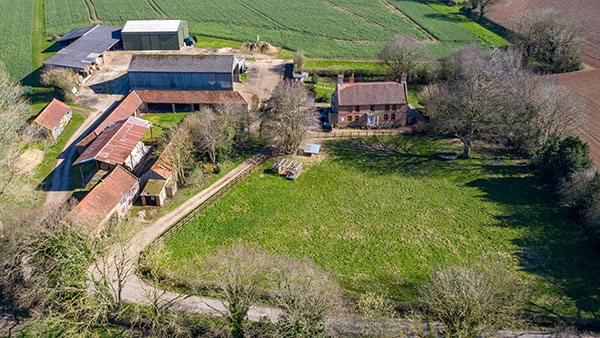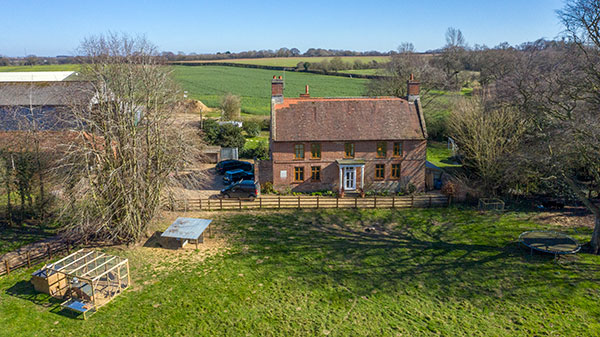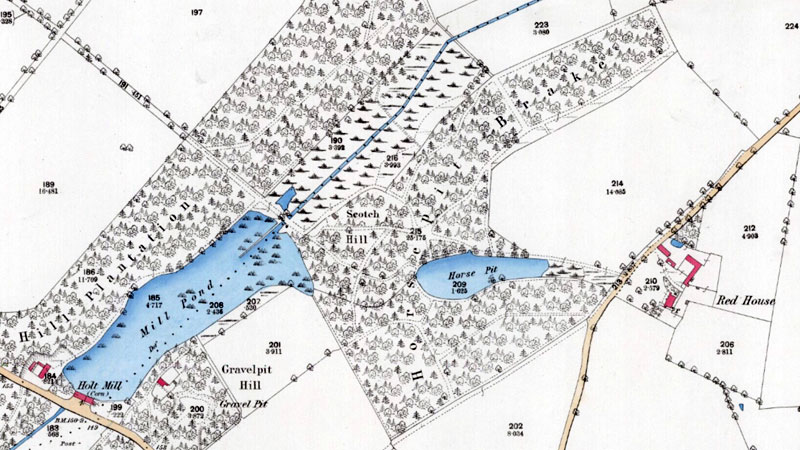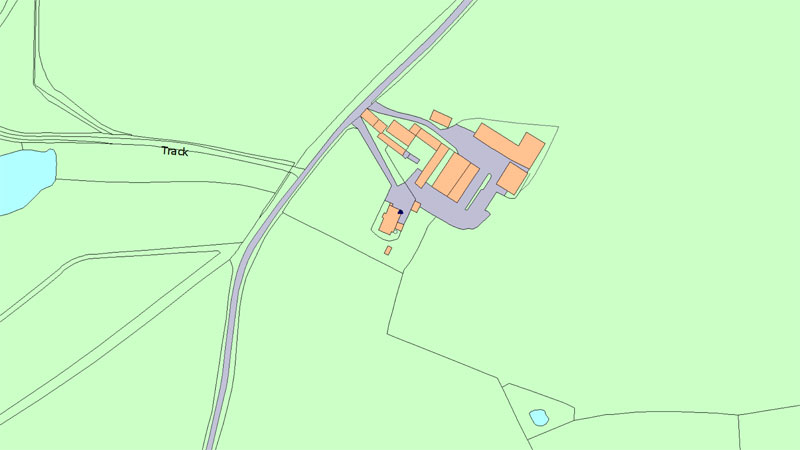 |
Hempstead |
|
 |
Red House Farm - 22nd March 2020 |
Court Green belonged to Red House Farm in the 1700s. |
Farmhouse, early 18th century, brick with patterned headers, plain tiles to front, pantiles to rear. Single range, three bays. Two storeys with attic and cellar. Gable end stacks with rebuilt shafts. Plinth with flint at base, platband, dentil cornice. Symmetrical facade: central doorway has porch with Tuscan entablature supported by two columns with upper part fluted, lower part smooth; five cross windows in pairs to bays one and three to ground and first floor, some with original leaded panes, fittings and pintle hinges, those to ground floor in reset openings. Plaque on left hand side to Samuel Fowles, d.1906, head keeper of the Hempstead Estate. Both gables with parapets, tumbled brickwork and eaves platband. Continuous outshut at rear, raised to 1½ storeys, with fenestration of 1980's. |
The first detailed knowledge of the buildings and land at Hempstead_Hall comes to us from the Book created William Newman in 1726 (NRO Het87). He succeeded his uncle, Thomas, as Lord of the Manor in 1698. Why he waited 28 years before embarking on his booklet is unclear. On the outside cover of William Newman's book in ink appears the following: On the inside there is a page heading - William took over in 1698 from Thomas, his uncle, but he created his Book only three years before his death in 1729. There then appears a “Survey of the Barn Farm or Red House Farm as the closes abutteth on each other”. This sounds as though perhaps the farm had been known as Barn Farm and had changed its name following the recent building of the Red House. The name of the occupier has been left out. The Red House and its barns are clearly shown on their present site. The house was of three stories, four windows on the first and second floors and three attic windows - but there was no pillared front door at this time. Horsepit Pond did not exist - nor did the present Mill nor did any of the ponds which feed the mill. “Selbrigg Lane” is shown as the present driveway to Selbrigg Cottage but continuing well beyond to the east as it ran through to Baconsthorpe Castle. “Court Green” - so described - belonged to Red House Farm. One curious difference between 1726 and the present day is that the current Selbrigg Cottage did not then exist. Instead, on the north side of the lane appears another cottage looking south. One can only guess that the Gurneys rebuilt it on a better site in the early 19th Century to house their highly skilled and no doubt hugely valued decoy keeper - facing north over the newly constructed Selbrigg pond and its decoys. Hempstead, A Norfolk Village - Robin Carver, 2000 |
 |
Red House Farm - 22nd March 2020 The farmhouse is Grade II listed |
Richard Joseph Gurney who, having inherited Green_Farm in 1773, went on to buy further land at Hempstead probably for its Glaven Valley shooting. It was his brother-in-law Robert Barclay who bought Northrepps Hall in 1790. The three brother and one sister, Rachel, reared thirty-six children between them - including "Betsy" who became in due course Elizabeth Fry, the great prison and social reformer.
The schedule refers to a map which is not with the other papers. There was a Horsepit Plantation of 16 acres so did this indicate that the Horsepit Pond was by now in existence? However, there is no reference to any pond at Selbrigg - only to "Selbrigg Meadow."
The list of tenants shows that the Landlord occupied 28 acres including"Selbrigg Cottage and Land" but the rest appears to be let with Joshua Coleby occupying 101 acres for which he paid £156pa. There were two cottages, a Blacksmith's Shop let to Daglass and a public house let to Tuck.
The tablet is made from Hopton-Wood stone and was sculpted by Eric Gill. In a book recording Gill's "Inscriptions" for 1906-1907, it is recorded that the table was "commissioned and designed by Edward Johnstone for his brother Andrew" and that "the composition of the inscription is exceptional". |
|||||||||||||||||||||||
At Red House Farm, Hempstead there is a tablet by Eric Gill, famous and notorious sculptor and typographer of the early twentieth century, which reads:
The Gurney’s, Buxton's and Barclay's of the nineteenth century were not exactly in the avant-garde of the artistic world - how is it that they employed an up-and-coming sculptor of whom they had probably never heard? At the Lettering Arts Centre at Snape there is currently an exhibition of the works of MacDonald Gill (the less well-known younger brother of Eric) who designed the standard gravestone for all the British dead in both wars (there is one in Hempstead churchyard). It is stated that he ‘studied lettering under the celebrated calligrapher and type designer Edward Johnstone'. Pennies then dropped. In the Hempstead Village History it is recorded that the tablet was ‘commissioned and designed by Edward Johnstone for his brother Andrew'. Andrew was a Buxton son-in-law but nothing was known of his brother Edward who, as it now turns out, was the father of modern lettering and able to influence an important commission for one of his pupils - Eric Gill. Mystery solved! The Gurney Hempstead Estate left several memorials. They built the Mill; three dams above it including Selbrigg_Pond; built a famous duck decoy on the Pond; and, at the Red House provided a honeymoon hideaway for Elizabeth Fry (recently pictured on the £5 note).
Church & Village News - Robin Carver, September 2014 |
 |
O. S. Map 1885 Courtesy of NLS map images |
 |
O. S. Map November 2023 Courtesy of Historic England map images |
If you have any memories, anecdotes or photos please let us know and we may be able to use them to update the site. Please
or telephone 07836 675369 |
Website copyright © Jonathan Neville 2020 |